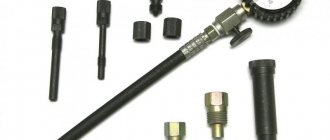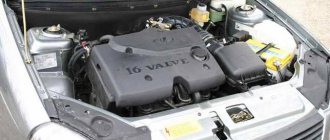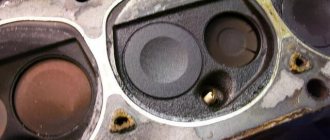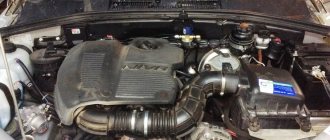— Simple design
, which is the key
to reliability
and
durability
, which is fully
applicable
to
8-valve engines
.
an engine
itself is
time-tested
and is equipped with
a minimum number of components
, a striking example of this judgment is only
one camshaft
, as well as
2 valves
per
cylinder
instead of
4 units
, as in a
16-valve
power plant;
- In such engines
Often
there are no hydraulic compensators
, which further
simplify
already
simple engine design
.
Power plants of this type
are equipped with
mechanical pushers
, which are much
simpler
in their
structure
, and
replacing
or
repairing
them is not difficult.
As a rule, motors
of this kind receive
plug-free pistons
, which are much more
durable than conventional ones
.
- Thanks to the simple design of the motors
8-valve valves
at all
demanding
on
fuels and lubricants
.
They can be filled with semi-synthetic motor oils
and
filled with low-octane
fuel;
— Such engines
much more
compact than 16 valves
, since they
do not have an additional shaft
.
This also translates
into
weight
and
fewer attachments
.
— The main disadvantage
Such
motors
are characterized by
the low power
they
develop
.
Typically, on average, the power of an 8-valve engine
is about
20 percent lower
than that
of a 16-valve
unit.
We must understand perfectly well that 8-valve valves
have only
2 valves
per
cylinder
, that is,
one
for
intake
and
the other
for
exhaust gas exhaust
, therefore
the system functions more slowly
and
it is simply
not destined
high speeds
like a
16-valve valve. ;
— Regarding fuel consumption
for such
engines
, it will be
higher
than for
16 valves
, since the process of
intake
and
exhaust
is
slower
.
Therefore, the engine
needs to
push the exhaust gases harder
with just
one valve
, that is,
the effort is applied
twice
as much
;
— Disadvantage
There is also
increased noise
during operation of the power plant, this is especially clearly
visible
at
high speeds
(
more than 60 kilometers per hour
).
An important nuance
is also that
mechanical pushers
adjusted
from time to time , and over time they
develop wear
and
gaps appear
.
Because of these moments
,
and
efficiency
the motors
noticeably
decrease , and
noise also increases
.
As we can see cheap maintenance of mechanical pushers
may hide
rapid wear
of parts.
— Also in frequent regulation
need
valve clearances
.
Although regulation
may not be done, then
the efficiency of the engine
will
decrease
and
fuel
consumption will increase
.
This question is not often, but consistently asked by my readers and channel viewers - what is better than 8 or 16 valves in the engine block head? Many people believe that the 8-valve version is a thing of the past and spending your hard-earned money on it is, at the very least, stupid! But 16 is YES, IT IS! Others, on the contrary, insist that the 16 valve version is more expensive, more demanding to maintain, and if it breaks, “write it down”! But where is the truth, and what exactly is the difference between these two units, are they very different? I propose to weigh all the pros and cons, so there will be a video version...
You know, there are really a lot of battles on the Internet on this never-ending topic, but I think everyone here is right in their own way. After all, some expect reliability and simplicity, while others expect greater power and smooth operation. The tasks are different, and the engines are different, but let's take a closer look.
Throughput and technical losses
Actually, the task of the timing belt, and in particular the valves, is one - to supply the air-fuel mixture as quickly as possible and also remove it from the cylinder block as quickly as possible . I think this is understandable and does not cause any difficulties.
How can you make the “mixture” flow faster? YES, everything seems simple, you need to increase the diameter of the hole!
Many engineers thought so too; on the first engines the valves were quite large, they closed large passages into the cylinder heads (which went to the intake and exhaust manifolds ). It should be noted that four-stroke engines had exactly 8 valves; this is a kind of classic design.
But a large valve has greater inertia and at high speeds mechanical losses increased. After all, the camshaft cam needed to push this heavy mechanism.
Then they began to decrease. Yes, losses have decreased, but throughput has also decreased.
How to get out of this situation?
We began to increase the number, that is, to make them miniature, but larger. This is how options with 12 – 16 – 20 and even 24 valves appeared. BUT, again, only two survived, the main types are 8 and 16, that is, 2 and 4 valves per cylinder (if we take a 4-cylinder engine).
How many cylinders are there in an engine?
Throughout the history of mechanical engineering, engineers and designers have pursued one goal - obtaining maximum efficiency from the engine. To achieve this, more and more powerful engines were developed with varying numbers of cylinders - from 1 to 16, and attempts were made and continue to be made to place “horsepower” in the smallest possible volume of engine compartment space.
Single-cylinder engines are installed in mini-tractors, low-power mopeds and motorcycles. For more powerful motor vehicles, a 4-stroke 2-cylinder engine is required. Modern three-cylinder internal combustion engines are mainly installed on small cars and are equipped with a turbine to increase power.
Important
4-cylinder engines have been the most popular in the automotive industry for over a hundred years. Almost all modern passenger cars are equipped with them.
Five-cylinder engines are not so popular. Previously, they were widely used by such giants of the global automotive industry as Volkswagen, Volvo, Audi
Six and 8 cylinder engines are also popular. Despite the worldwide practice of reducing the number of cylinders due to turbocharging, such internal combustion engines are gradually losing their positions. In recent years, many automakers have been abandoning eight-cylinder engines in favor of 6-cylinder engines, this is especially noticeable in the market for powerful passenger cars.
ICEs with 7 or 9 cylinders are used in aircraft. They are not used in the automotive industry, with rare exceptions - in tuned models. 10- and 11-cylinder engines are also very rare in the automotive industry. You can admire the “ten” in the Audi R8 sports car.
The 12-cylinder engine was used more widely in the auto industry. But due to tightening environmental regulations, their production is inexorably declining.
There are also internal combustion engines with 14, 16, 18, 20, 24, 28, 32 and 64 cylinders. They are a combination of several engines with fewer cylinders and are practically not used in automobile production.
The order of operation of the cylinders and why this is so
There are two types of 4 cylinder engines:
- in-line;
- Opposite.
The crankshaft layout is the same, but the order of operation of the cylinders is different. This is due to differences in the design of the gas distribution mechanism, ignition system, and also depends on the angles between the crankshaft cranks.
The in-line 4-cylinder engine operates in a 1-3-4-2 operating order. It is used in the vast majority of cars - both diesel and gasoline, from Lada to Mercedes. Here, cylinders located on opposite journals of the crankshaft operate sequentially. The order of operation of the cylinders of a 4-cylinder opposed internal combustion engine is organized in a different sequence: 1-3-2-4 or 1-4-2-3.
In this case, the pistons reach top dead center on both sides at the same time. “Opposed” cars can be seen on almost all Subaru models, with the exception of some small cars sold on the domestic market.
Which power unit is better to choose?
If we summarize all the above features, then the following becomes clear:
- An engine with 8 valves is easier to maintain, cheaper to repair, works better on low-quality fuel and oil, and is well suited for installing gas equipment. At the same time, such an engine consumes more fuel, produces less power, is more vibration-loaded and noisier.
- A power unit with 16 valves allows for better dynamics, it is more powerful, consumes less fuel, and does not vibrate as much. In parallel with this, the requirements for the quality of fuel and lubricants are increasing, and the costs of maintenance and repairs are increasing.
If there is a choice between these two types of internal combustion engines, then individual preferences and features of subsequent operation should be separately taken into account. In cases where dynamics and efficiency are needed, and the car is planned to be serviced at a professional service station, then it is optimal to purchase a more technologically advanced 16 valve version.
If the issues of dynamics, power and fuel efficiency are not so important, and you plan to service the car yourself to save money or taking into account the inability to visit a service station, then an engine with 8 valves looks like a more suitable option.
It turns out that their main advantages remain a more affordable initial price of the car, less sensitivity to fuel and the composition of the fuel-air mixture, as well as ease of repair, especially with self-service.










